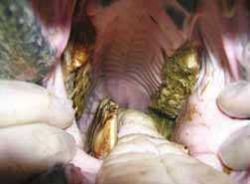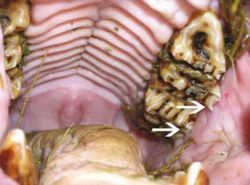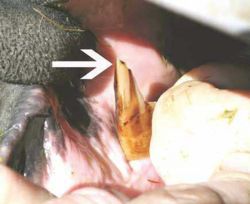Dental Overgrowths - Donkey
Introduction
The most common dental (and oral) disease is the development of sharp dental overgrowths (‘enamel points’) on the lateral edges of the maxillary and the medial edges of the mandibular cheek teeth that result in lacerations of the cheeks and the tongue.
Pathogenesis

The equine maxillary cheek teeth arcades are normally 23% further apart than their mandibular counterparts, with both arcades sloping ventrally downwards towards the outside of the mouth (i.e. in the buccal direction). As noted, this absence of complete occlusal contact between the upper and lower cheek teeth (as opposed to human dental occlusion) predisposes to the development of enamel overgrowths (‘enamel points’) laterally (on the outside) of the maxillary, and medially (the inside) of the mandibular cheek teeth.
These overgrowths are largely due to domestication, with the associated feeding of concentrates, which limit the time a donkey chews its food – normally up to 18 hours a day in donkeys at pasture. The feeding of grain and processed food also limits the normal lateral jaw movements and further promotes the development of overgrowths. When the mandibles are even narrower than usual, these dental overgrowths may become more pronounced. The prime role of the lay equine dental technician is to prevent these overgrowths from developing by routine and effective tooth rasping.
If these painful dental overgrowths are neglected, the sharp enamel points will eventually merge into a steeply angled occlusal surface termed ‘shear mouth’ or ‘scissor mouth’, i.e. the occlusal (chewing) surface of the teeth may end up with a 45º (versus normal 10-30º) angulation. In the presence of these large dental overgrowths, a mechanical obstruction may now, in addition to the pain, prevent the normal side-to-side jaw movements, and mastication will be even less effective.
Food stagnation will occur at the gum margin, due to lack of normal food and salivary movement around the oral cavity and this will then cause secondary periodontal infection. As dental eruption is dependent on healthy periodontal membranes, teeth that have marked periodontal disease will erupt more slowly than adjacent teeth with healthy periodontal membranes. This may lead to the occlusal surface of the cheek teeth developing an uneven or undulating occlusal surface, termed ‘wave mouth’.
Deep periodontal disease can lead to tooth loss, especially in older donkeys with short reserve crowns. Following tooth loss, the opposing tooth will erupt more rapidly, leading to the dental irregularity termed ‘step mouth’. These abnormalities of wear are progressive, leading to oral pain, quidding, bad breath (halitosis) and eventually weight loss.
Clinical signs


These sharp dental overgrowths cut the cheeks and the tongue during mastication and cause oral pain. Likewise pain from other types of localised dental overgrowths (colloquially termed ‘hooks’, ‘steps’, ‘ramps’ and ‘shear mouth’) or from secondary periodontal disease (inflammation of the tissue that attaches the teeth in the socket) may result in boluses of partially masticated food falling from the mouth during chewing, a condition termed ‘quidding’. Quidding occurs during the early stages (oral phase) of swallowing. Boluses of food may be visible on the ground outside the animal’s box or beneath the forage rack.
Donkeys with dental overgrowths may not fully clear their mouths of food. Semi-permanent ‘hamster-like’ cheek swellings may occur in badly affected cases, due to the accumulation of fibrous food wedges between the lateral aspects of the cheek teeth and the cheeks. In the presence of oral pain, and later to mechanical factors (due to large dental overgrowths which prevent the normal sideways jaw movements), some donkeys may also chew very slowly and make soft ‘slurping’ sounds rather than the normal vigorous ‘crunching’ sounds whilst chewing. A donkey with oral pain may also use just one side of its mouth for chewing rather than using alternative sides or may hold its head in an abnormal position during eating.
In extreme cases, decreased food intake and possibly inefficient food digestion and utilisation may eventually occur, leading to weight loss, but this is only associated with severe dental disorders or oral trauma, and so the absence of weight loss does not indicate absence of dental disease. With dental disease, long strands of forage and undigested whole grain particles may be present in the faeces. However, most donkeys with a painful mouth will just spend longer eating, including re-eating quidded food from the floor. Halitosis may be present if widespread periodontal disease or advanced caries (infection of the mineralised components of teeth) are present.
Painful dental-related lesions may also cause bit (bitting) problems in ridden or driven donkeys, including abnormal head carriage and headshaking during work. This is commonly because overgrowths on the rostral upper cheek teeth may cut into the cheek mucosa. Additionally, the tongue can be compressed by the overlying bit and forced against sharp overgrowths on the lower cheek teeth, and this will also cause discomfort.
Treatment
Treatment of these disorders will require veterinary attention and includes removal of major overgrowths, preferably by power tools, followed by careful rasping of reduced teeth to smooth off any sharp edges. Loose teeth can be extracted orally by a veterinary surgeon, using specialised equine ‘molar extractors’ in standing, sedated donkeys. As noted, the aim of routine dental care should be to prevent the development of such endstage conditions by once- or twice-yearly dental inspections. At routine examinations, any detected overgrowths should be removed, thereby encouraging normal chewing activity and allowing the free movement of food and saliva around the oral cavity.
References
- Dacre, I., Dixon, P. and Gosden, L. (2008) Dental problems In Svendsen, E.D., Duncan, J. and Hadrill, D. (2008) The Professional Handbook of the Donkey, 4th edition, Whittet Books, Chapter 5
|
|
This section was sponsored and content provided by THE DONKEY SANCTUARY |
|---|